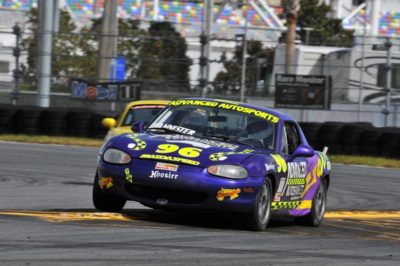Your competitor is not going to make passing an easy task for you. But he or she has a weakness, and it’s up to you to find it and exploit it.
Whether you’ve been stalking a competitor for the entire race or just caught him or her, you’re not there to settle for the position you’re in. You want that position, whether it’s to win the race or just break into the top 10. Of course, the person you’re trying to pass is equally determined. You have to figure out when and where you can make an attempt without your competitor having much he can do about it.
“When you’re trying to pass someone, you’ve got to study on the fly,” says 2015 Indy Lights Presented by Cooper Tires Champion Spencer Pigot. “If you’ve been behind him in practice, then maybe you have an idea of where you’re a little bit quicker; but usually you’ve got to study right then and there in the race and it can be tricky sometimes, because there’s so many other things you have to focus on. If they’re understeering a little bit in the middle, or tend to lock their brakes up a little bit or miss their apex in a certain corner … wherever their weakness is, you just have to make sure you hit that corner perfectly, because some cars on some tracks are very difficult to pass, and you only get one shot. And once you decide to go for it, you have to commit to it.”
Pigot notes that it’s not in the corner where your competitor has vulnerability that you’re likely to make the pass, but in the next turn. If they’re struggling in a corner, their exit is going to suffer and they’re going to be slower down the following straight.
How you approach finding a weakness may depend on whether you’ve just caught your target, or you’ve been stalking him or her for much of the race.
“Start with how you approached them,” says Mazda SKYACTIV Prototype driver Joel Miller. “If you just caught them, and if you kind of attack at the first opportunity – obviously he knows you’re there, but he doesn’t think you’re going to jump that quickly. So the weakness in him is he doesn’t know you’re going to do that.”
That particular situation isn’t so much as finding a weakness as making one. Another way to do that, Miller notes, is to cloud his mirrors and get them looking. Taking their focus off the track ahead and running their line may force a mistake – you’ve got to be ready to move when it happens, though. And sometimes a driver that is ready for you creates a weakness where there wasn’t one before.
“If you’ve been running with a guy for a while, you may know he’s going to defend the heck out of you,” says Miller. “Well, that’s his weakness. He’s going to defend me, so on the next straightaway, that’s where I’m going to have to make my move. It’s kind of like chess – moves and countermoves. I like chess, so I love setting guys up. That’s where I find the weakness – when you make a guy take the bait, then you go after it.”
Once you’ve been following a competitor for a while and have figured out where you’re going to make your move, there is some value to keeping that card in your pocket until it’s time to play it, notes Continental Tire SportsCar Challenge champion Stevan McAleer.
“I feel that the corners that you’re looking to make your move on, the one that you’re going to make an attempt to pass, that’s the one you can’t give up your hand until you do it,” McAleer explains. “The way I play the chess game is to show my nose in a bunch of other places that might either slow them up or cause an error leading to the corner where I feel is the biggest opportunity I can pass.
“At Circuit of the Americas with Spencer Pumpelly – you’re dealing with certainly one of the best guys in the business – and I was super excited to have a one-on-one race with him,” he says, describing one race in which the method almost worked for him. “He had more straight line speed all the way down the straight, but we had more cornering ability. So in a move you’d think would never be worthwhile because of the straight, I passed Spencer on the last lap in the hairpin leading onto the back straight. From an outside point of view, he’s going to drive right back by me, because he was faster on the straight. The way I looked at that move, is that’s absolutely correct. But he’s going to pass me further down the straight, rather than having a bigger gap coming out; so I was basically trying to make that gap smaller.”
Pumpelly and teammate Luis Rodriguez Jr. won that race, but it’s an illustration of trying to reduce the efficacy of a competitor’s strength – the next best thing to finding a weakness. And whether it’s finding a way to reduce your target’s strengths or exploiting the weaknesses, the result is ideally one more position and a little extra satisfaction when the race is done.


 ACCESSIBILITY
ACCESSIBILITY